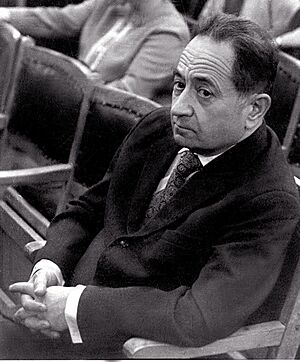Dmitri Klebanov facts for kids
Dmitri Lvovich Klebanov (Ukrainian: Дмитрo Львович Клебанiв; Russian: Дмитрий Львович Клебанов; July 25, 1907 – June 6, 1987) was a Ukrainian Soviet composer. He was a very talented musician who played several instruments and wrote many different kinds of music.
Dmitri Klebanov studied at the Kharkiv Music and Drama Institute and finished his studies in 1926. Later, he became a professor of composition at the Kharkiv Conservatory in 1960, teaching many students, including famous composers like Valentin Bibik and Vitaliy Hubarenko.
Contents
Dmitri Klebanov's Musical Journey
Klebanov was trained in many areas of music. He learned to play the piano and viola, and also became a conductor and a composer. In the late 1930s and early 1940s, some of his major works, like ballets, a violin concerto, and a symphony, were performed in big cities like Moscow and Kiev.
Facing Challenges with His Music
However, Dmitri Klebanov faced a big challenge with his first symphony, titled "In Memoriam to the Martyrs of Babi Yar" (written in 1945). This piece was about remembering the victims of a terrible event. The government's critics at the time found it "anti-patriotic," meaning they thought it didn't support their country enough. They also accused him of changing the true story and being too focused on one nation. Because of this, his symphony was put away in archives and not performed for a long time.
During this period, the leader, Stalin, criticized many Soviet artists. It was decided that one composer would take the blame for everyone, and Klebanov was chosen. Luckily, he wasn't sent away to a harsh place like Siberia. Instead, he had to live a quiet life and mostly wrote music that followed the government's rules, with titles like "Ode for the Party" and "First of May" Symphony. This was like being exiled, even if not officially, for about thirty years.
A Comeback and Lasting Legacy
In the 1980s, as the Soviet Union began to change, things started to get better for Klebanov. In 1983, a violinist named Mela Tenenbaum visited Kharkiv. She met Klebanov, and he suggested she perform his Violin Concerto. It was a success, and he then wrote a viola concerto especially for her. This new work was well-received in several Russian cities, and Klebanov felt his creativity flowing again.
He then wrote another new piece called Japanese Silhouettes, which used Japanese poems called haiku. This work was recorded for Radio Kiev, and it seemed like Klebanov was finally going to be fully recognized again. Sadly, he passed away in 1987, just before his 80th birthday. Soon after, the Soviet Union started to fall apart, and his music seemed to disappear. Many thought his scores were lost in a fire and flood that destroyed the building where they were kept.
Dmitri Klebanov's Music
Dmitri Klebanov wrote a wide variety of music, including operas, ballets, and many pieces for orchestras and smaller groups of instruments.
Operas and Ballets
Klebanov composed several operas and ballets. Operas are like plays where the story is told through singing, and ballets tell stories through dance.
- By One Life (1947)
- Vasily Gubanov (1966)
- The Communist (1967) – a new version of Vasily Gubanov
- Red Cossacks (1971)
- The Baby Stork (1934) – a children's opera
His ballets include:
- The Baby Stork (1936)
- Svetlana (1939)
Orchestral Works
Klebanov wrote many pieces for a full orchestra, which is a large group of musicians playing different instruments. He composed nine symphonies, which are long musical pieces usually in several movements.
- Symphony No.1 In Memoriam to the Martyrs of Babi Yar (1945)
- Symphony No.2 (1952)
- Symphony No.3 (1956)
- Symphony No.4 (1958)
- Symphony No.5 (1959)
- Symphony No.6 (1981)
- Symphony No.7 (1982)
- Symphony No.8 "Poeme about bread" (1983)
- Symphony No.9 (1989)
He also wrote other orchestral pieces like:
- Ukrainian Concertino (1940)
- Ukrainian Suite (1949)
- Heroic poem (1975)
Concertos and Chamber Music
A concerto is a piece of music for a solo instrument (like a violin or cello) and an orchestra. Klebanov wrote several concertos:
- Concerto No.1 for violin and orchestra (1939)
- Concerto No.1 for cello and orchestra (1950)
- Concerto No.2 for violin and orchestra (1951)
- Concerto for dombra and orchestra (1956)
- Concerto for flute, harp, string orchestra and percussion (1974)
- Concerto No.2 for cello and orchestra (1977)
- Concerto for viola and string orchestra (1983)
- Japanese Silhouettes for viola d'amore, soprano and ensemble (1987)
Chamber music is written for a small group of instruments, usually one player per part. Klebanov composed many chamber pieces, including:
- Six String Quartets (1925, 1926, 1933, 1946, 1966, 1968)
- Two Piano Trios (1927, 1958)
- String Quintet (1953)
- Wind Quintet (1957)
- Piano Quintet (1962)
Images for kids



